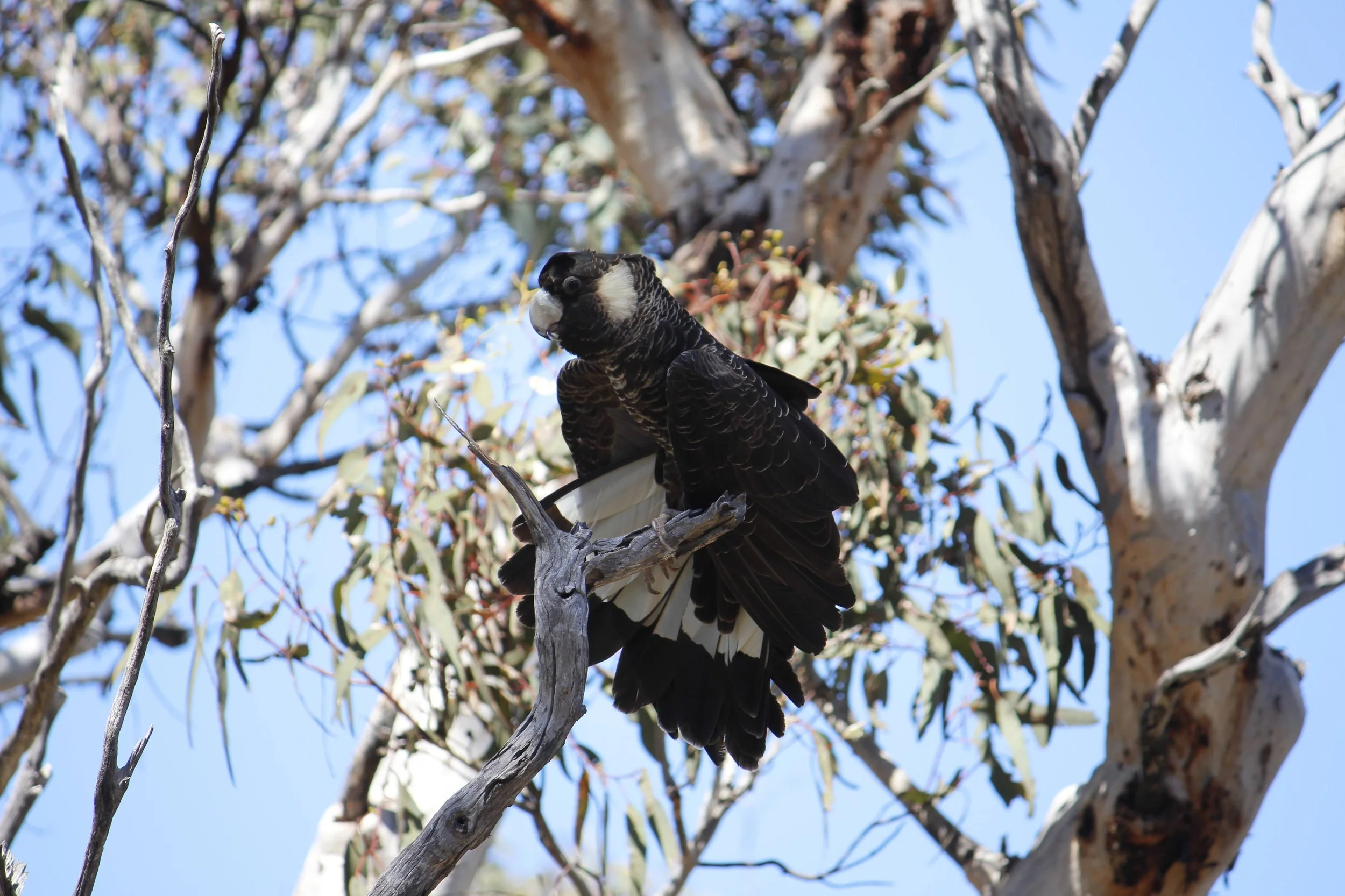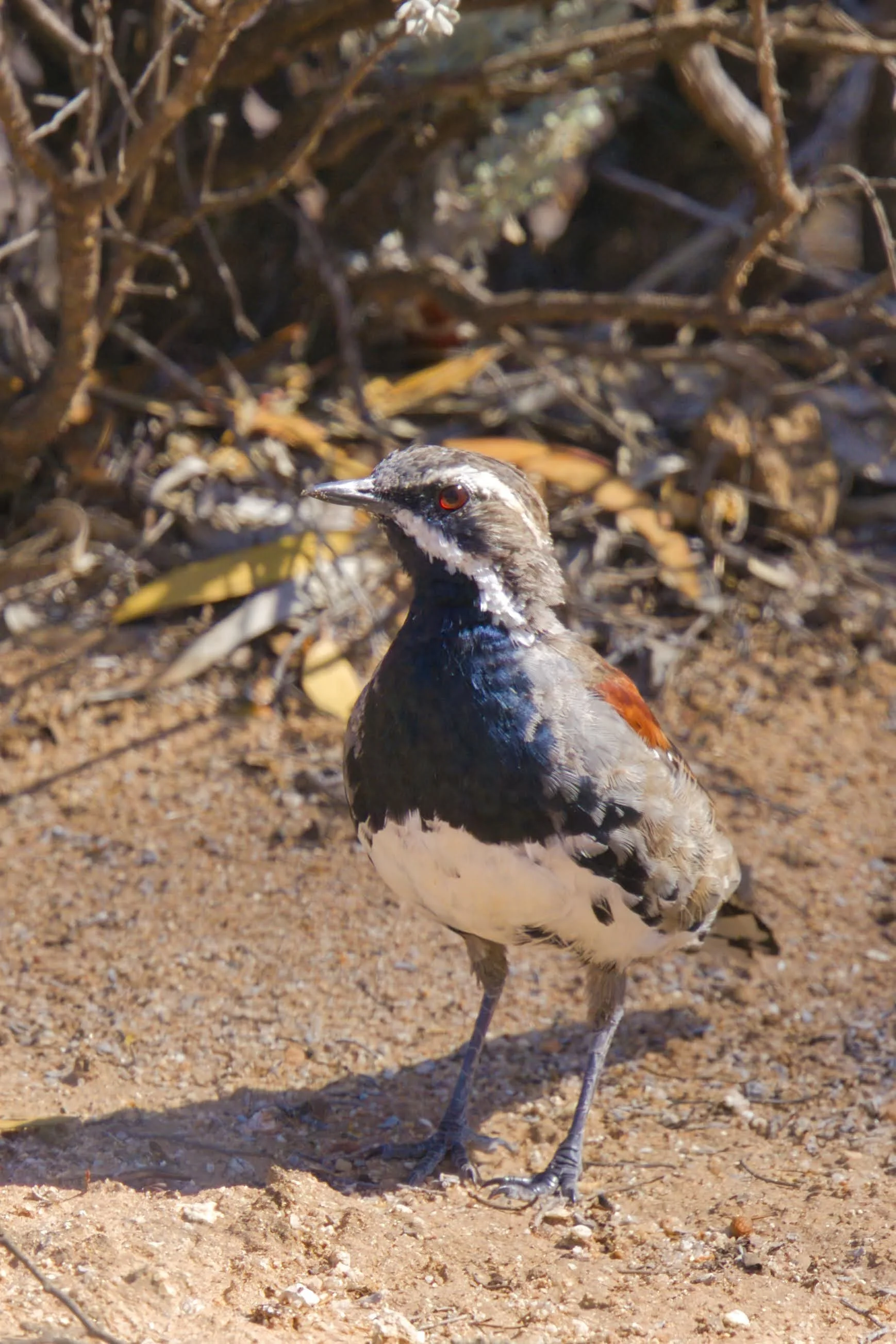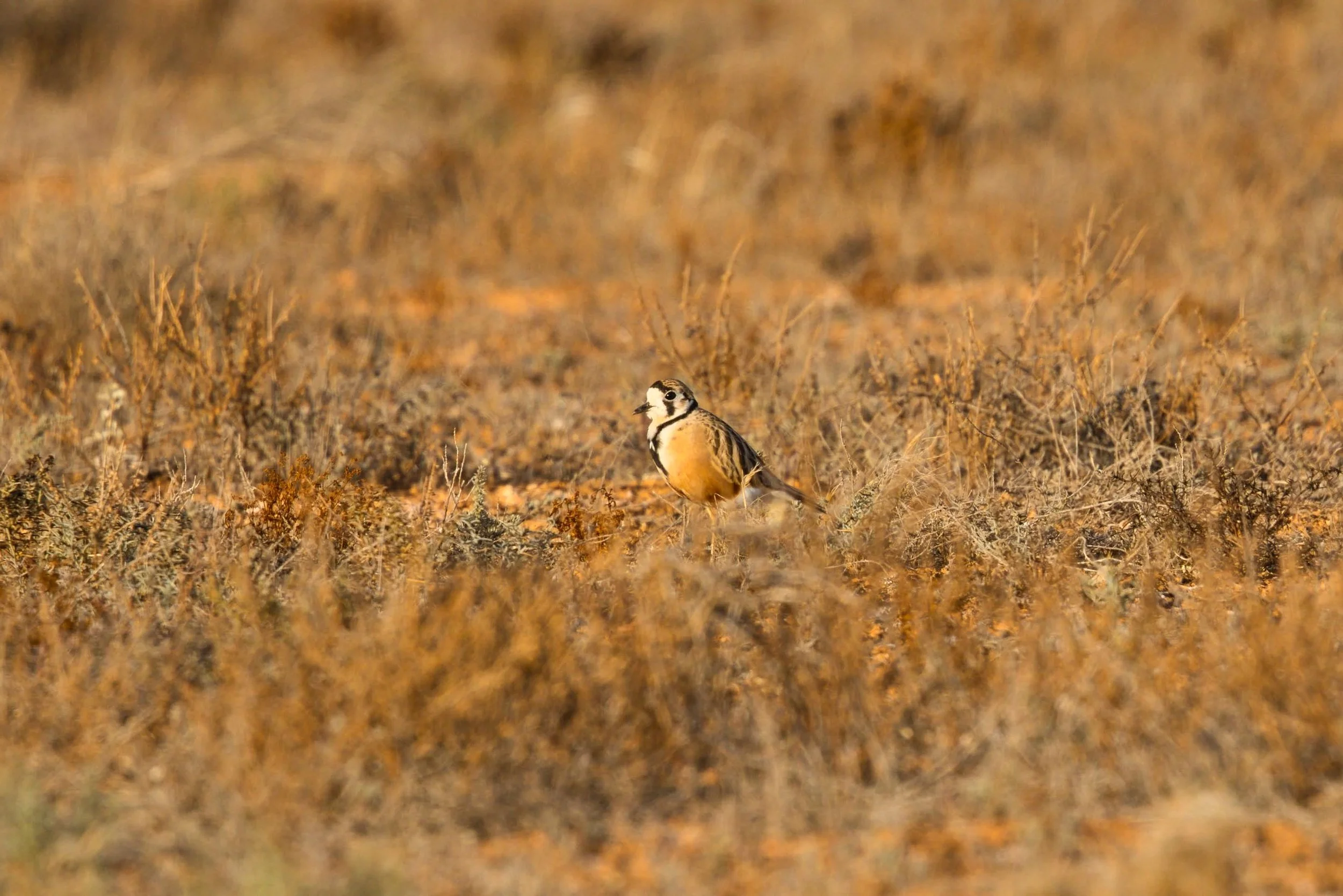
Nullarbor & Southwest
Nullarbor & Southwest
Western Endemics, Splits & Specialties
Leader: Louis Masarei
Group size limit: 3
Upcoming Departures:
Price: $ 11090 AUD
Single Supplement: $ 700 AUD
April 2026 (TBA)
-
We’ll start things off early in Perth and visit some of the local lakes that make up a huge expanse on the Swan Coastal Plain. Here we will hope to find a variety of waterfowl including Musk Ducks and Blue-billed Ducks. The we will begin to make our big trip east towards Kalgoorlie. As we make our way through to the Darling Escarpment, we will look for Carnaby’s Black Cockatoo and the local subspecies of Red-tailed Black Cockatoo. Crossing from Jarrah-Marri woodland, into Wandoo woodland there will be opportunities to find Western Shrike-tit, Rufous Treecreeper and Western Yellow Robin. We will likely also bump into our local subspecies of Australian Ringneck – the 28. Then as we move through the wheatbelt, we will stop at certain towns to find Western Corella. Along the rest of the way to Kalgoorlie we will stop for short birding breaks at remnant woodland patches where we may pick up Purple-crowned Lorikeets and Yellow-plumed Honeyeaters before arriving for dinner in this historic mining town.
-
The morning will bring us our first chance at Copperback Quail-thrush. These birds are an exciting bird to track down amongst the glowing Great Western Woodlands. Other birds we could pick up in this area are White-fronted Honeyeaters, Gilbert’s Whistler and Purple-backed Fairywrens. The sewage treatment plant is always worth a visit in Kalgoorlie too where we will likely see Pink-eared Ducks and Australian Shoveler amongst Black Swans and Pied Stilts. These woodlands are on the edge of much more arid country to the north and east and depending on the season can have birds sheltering from drought around the towns water sources such as Zebra Finch and Black-tailed Nativehen. We will head through the woodlands and then out towards the Nullarbor throughout the afternoon, arriving at Cocklebiddy by the evening. Depending on timing, we may pop out through dusk to find Slender-billed Thornbills and Inland Dotterels.
-
We will have an early morning start for our trip down to the Eyre Bird Observatory, famous for its Pink Cockatoo population. Hopefully they will be visiting the bird baths alongside the many Brush Bronzewing and put on a show for us for the morning session. The grounds around the observatory provide wonderful viewing opportunities for smaller passerines such as Spotted Scrubwren, Blue-breasted Fairywren and Spotted Pardalote. This morning and its photographic opportunities will likely provide us with some of the best memories of the trip. We will be torn away from the bird baths to head out onto the Nullarbor proper heading up and down wonderful and unique escarpments towards Eucla and beyond, perhaps stopping for Australian Bustard or to visit some Southern Hairy-nosed Wombat burrows.
-
Today will likely provide more highlights of the trip with our first chance for Naretha Bluebonnets. These wonderfully coloured small parrots light up the dry and dusty Nullarbor colour pallet with bright reds and blues. If we are lucky, Mulga Parrots will also visit us to add to the colour pallete. Throughout the bluebush plains on the way in and out of our Bluebonnet spots, we will look for the incredibly skulky Nullarbor Quail-thrush. This is one of the more difficult birds to see well on the trip and we will spend some good time searching for them. In this same habitat we are likely to encounter Rufous Fieldwrens and Southern Whiteface. There are many Southern Hairy-nosed Wombats around the area and if we are lucky we will see one basking at the entrance to its burrow as the light fades throughout the day and we turn into our accommodation.
-
Today we will focus on either, Naretha Bluebonnets or Nullarbor Quail-thrush depending on which we still need to see well. Inland Dotterels and more Southern Hairy-nosed Wombats will also be on the cards as we search the open plains amongst the bluebush. There are also chances to see Spotted Harriers cruising low over the shrubs, White-winged Fairywrens and Slender-billed Thornbills as well as Red Kangaroos. We will then make our way back west where we may pick up Spiny-cheeked Honeyeaters and Banded Lapwings. It will also be worth a check over the Bunda Cliffs for some early Southern Right Whales and enjoy the view. If the timing is right, we could afford another trip to the Eyre Bird Observatory for Pink Cockatoos if our first visit wasn’t quite enough!
-
We will continue on West this morning, back towards the Great Western Woodlands. Gilbert’s Whistler may still be a target as we move through the coppery trees but before we know it we will be head south towards Esperance. Through the afternoon we will look for Cape Barren Geese. These are an endemic subspecies to Western Australia. Black-faced Cormorant are also a local specialty for those Western Australian listers. The RAMSAR listed wetlands hold a great diversity of waterbirds, sometimes many Hooded Plover but also have Banksia lined edges where Western Wattlebird and Carnaby’s Black Cockatoo forage in good numbers. Esperance is quite large despite its isolation and will be a welcome change to the accommodation and food found out on the Nullarbor as well as an important transition as we begin to move into the Southwest proper.
-
Rock Parrots will be our first call of the day. They’re found foraging on the pure white beaches of Esperance alongside Western Grey Kangaroos. Sometimes they take a bit of finding but the search is often well worth it if not only for the scenery of the Recherche Archipelago in the background of Cape Le Grand and Cape Arid. The coastal heath also holds Southern Emu-wrens, Western Fieldwrens and Red-eared Firetail which we will search for before continuing west to Bremer Bay. On the edge of Bremer Bay is the Fitzgerald River National Park. Western Whipbirds and Malleefowl call this park home though they are difficult to see. In the afternoon we will focus on finding a Western Whipbird before preparing for our pelagic trip in the morning.
-
The trip out to Bremer Canyon is one of the best single day pelagic experiences on the planet. The cetacean diversity is incredible from Long-finned Pilot Whales to Sperm Whales, the slim chance of beaked whale species and of course Orca stealing the show. The birds aren’t bad too. The regulars are Great-winged Petrel, Flesh-footed Shearwater, Shy Albatross and Indian Yellow-nosed Albatross but this pelagic has also turned up rare sightings of Barau’s Petrel, Cory’s Shearwater, Great Shearwater and Amsterdam Albatross. All eyes will be peeled for cetaceans and seabirds in an action-packed day. On the way back in, we have a chance for Rock Parrots on an island that Australian Sea Lions use to rest and bask. This island also supports a Crested Tern and Bridled Tern colony in the right season. By the evening, we will be well and truly in the Southwest at Cheynes Beach listening to Noisy Scrub-birds call.
-
We’ll get stuck straight into the skulkers this morning. Starting with Noisy Scrub-birds, we’ll walk the trails between the heath and visit the territories of various individuals. These birds are the star of the Southwest and are known well by Birding Southwest guides. Along the way, Western Whipbirds and Western Bristlebirds may be heard and traced down over their larger territories. Add to that, Red-eared Firetails, Red-capped Parrots, Wester Spinebill, Tawny-crowned Honeyeaters, Western Wattlebirds and much more - the soundscape throughout this heath is unbeatable! We have plenty of time here so we will spend it getting the best views of the skulky and not so skulky residents and visitors to this special place. A home-cooked meal awaits us at our cabins where we may still be able to hear the last calls of the heath for the day.
-
If we’ve missed anything the day before or need to upgrade our views, we still have the morning at Cheynes to chase those skulkers down before breakfast. After we’re fed, we’ll pack up and head north to some of the best Mallee spots. Southern Scrub-Robin, Purple-gaped Honeyeater and Shy Heathwren await. We may even bump into a Malleefowl not far from a known nest mound. Blue-breasted Fairywren and White-browed Babbler are residents in this area too so we will pick them up as needed before heading to the Stirling Ranges. Along the roads we will look for Baudin’s Black Cockatoo, Western Rosella and Regent Parrots. They regularly forage along the sides of the roads or use them as flight corridors. Our comfortable retreat for the evening has very birdy grounds which contain Western Thornbills amongst many others.
-
First thing in the morning, we’ll head out to track down Western Fieldwrens. They sing well early in the morning if the conditions are right and can be tracked down before breakfast. We’ll return to the grounds of the retreat to see what’s flitting around the bird baths. Gilbert’s Honeyeater are regulars while Regent Parrots, Purple-gaped Honeyeater & Western Shrike-tit visit too. Then it’s time to head further west to the tall tress of Pemberton. Along the way we will visit the southern subspecies of Western Corella, geographically isolated from their northern counterparts. Then into the wetter Karri forests that Red-winged Fairywrens, Baudin’s Black Cockatoo & White-breasted Robin call home. We’ll search for them before the sun sets and we return to our accommodation for the night.
-
We will wake to the sounds of the Karri Forest. Red-capped Parrots may still be on the list and are regularly seen around our accommodation. Those wet forest specialists - Red-winged Fairywrens, Baudin’s Black Cockatoo & White-breasted Robin may be too and we will venture into their habitat again if necessary. We will then head to the west coast. Hooded Plover and Bridled Tern are seen along the long beaches and rocky islands, as are Rock Parrots. We’ll look for these before searching out Western Spinebills and Western Rosella. As we head north along the coast towards the Busselton area, we will begin to see the edge of the Vasse-Wonnerup wetland system which can hold an abundance of wetlands birds. This is a wonderful area to pick up many different species such as Spotless Crake and Yellow-billed Spoonbill.
-
As morning breaks on our penultimate day, we will check the wetlands once more. Our local subspecies of Splendid Fairywren may be a target before we head back inland to Dryandra. This will return us to some of the Wandoo woodlands we began the tour with and give us our first chance at finding a Numbat. As the evening fills in, we will look for Painted Buttonquail, White-eared Honeyeater and anything else we are yet to see. Dinner in the woodlands will be followed by a look for Woylie, Chudditch & Western Brush Wallaby as well as Southern Boobook & Tawny Frogmouth.
-
Our last morning will give us great opportunities to complete our lists and upgrade our views and photos. This woodland is a fantastic spot for Western Shrike-tit which can be a difficult bird to track down. Dusky Woodswallows, Restless Flycatchers, Purple-crowned Lorikeets & Yellow-plumed Honeyeaters will be waiting for us too. We can take the opportunity to look for more Numbats before we make our way back to Perth. The trip back to Perth provides us with even more opportunities to find anything we’ve missed with various habitats along the way. We will finish up with lunch and a look at some local wetlands before returning you to your chosen accommodation. You are welcome to join us on Rottnest Island the following day as an extension where Quokka, Banded Stilt and the local subspecies of Red-capped Robin await– make sure to let us know if you are interested.
















